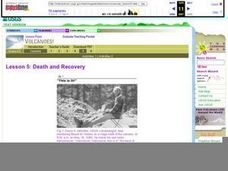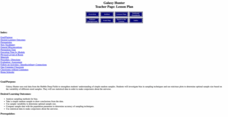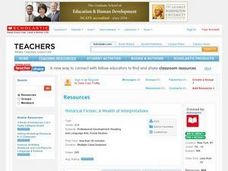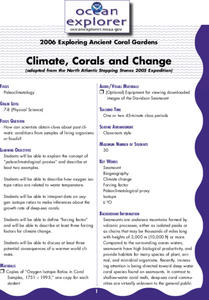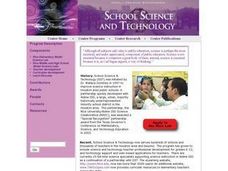K20 LEARN
The K20 Chronicle, Lesson 1: What Makes a Good Article?
Good news articles are engaging, informative, and often compelling. In the first lesson plan of the four-part series, young journalists analyze and evaluate news stories about former NBA player Enes Kanter Freedom. They learn about the...
Curated OER
Showdown on the Frontier
Especially critical following a series of shootings in schools, theaters, and religious buildings, it's safe to say that we need to evaluate the current laws on gun control. Eighth graders read a New York Times article in order to better...
Curated OER
Is Mr. Wolf Really A Bad Guy?
Is the wolf from "The Three Little Pigs" really big and bad, or is he just misunderstood? To analyze the effect of point of view, middle schoolers read Jon Scieszka's The True Story of the Three Little Pigs and evaluate the information...
Curated OER
Death and Recovery
Mount St. Helens erupted on May 18, 1980, devastating plant and animal life for miles around. Two activities are included in this lesson plan. In one, learners evaluate tree rings to determine the age of a tree and the year of a volcano....
Curated OER
Life in the Crystal Palace
Marine biologists research sea ice communities. Assign some groups to construct paper models of sea ice communities in winter, and some to construct models of them in summer. The lesson is simplistic, but the Internet resources provided...
Curated OER
Galaxy Hunter - A Cosmic Photo Safari
Space science stars journey through our night sky and take virtual photos of galaxies to investigate simple random samples. Higher math is used to analyze the data collected. Copy the evaluation/assessment questions onto a handout for...
Curated OER
The Civil Rights Movement, Phase II: 1960 - 1990
Students explain the impact of events leading up to the development of federal civil rights. They identify methods used to expand the right to participate in the democratic process and evaluate how governments achieve their stated ideals.
Curated OER
Historical Fiction: A Wealth of Interpretations
How can understanding the genre of historical fiction help your language arts class with literary analysis? Use this instructional activity to help young readers learn about historical fiction. After reading a selection from the "Dear...
National Endowment for the Humanities
How to Win a World War
High schoolers are have begun to learn the art of diplomacy with each other, but do they understand how diplomacy works at a global level? The second in a series of four lessons, guides scholars in evaluating primary sources. The why...
Curated OER
Planning to Parent: Do I Want Children? How Many? When?
Using the jigsaw method, ten different life situations relating to parenting are evaluated and then presented to the class. Through this experience, participants understand the reasons for choosing whether or not to have children, how...
Curated OER
Does The Type of Mulch Used Affect Plant Growth?
Students measure, record and graph the plants they grow in a controlled setting. They feed and water the plants as needed and use the scientific method to evaluate the growth.
NOAA
Climate, Corals and Change
Global warming isn't just an issue on land; deep ocean waters are also showing troubling signs. Young scientists learn more about deep water corals and the many recent discoveries researchers have made. Then they examine data related to...
Curated OER
Malaysia: Foreign Investment Returns
Young scholars examine the Malaysian economy and the effect of the SARS epidemic. They conduct research, write an editorial evaluating Malaysia's proposed budget for 2004, and develop an advertising campaign to promote business in Malaysia.
Gilder Lehrman Institute of American History
A Different Perspective on Slavery: Writing the History of African American Enslaved Women
Students examine the experiences of African-American women during the Civil War. Reading letters and autobiographies, they gain insight into how they dealt with slavery and losing their children. They create a model to evaluate the...
Curated OER
Measure Mania
Groups of students rotate through five classroom stations to estimate, measure, and record volume, length, weight, mass, and area using both customary and metric measure. They evaluate their data to determine how close their estimates...
Curated OER
The Argument
After brainstorming, middle schoolers write an expository essay for a writing project. They focus on supporting points, organization, and writing conventions to develop a well-integrated paper. In addition, they revise, proofread and...
Curated OER
Gravity Versus The Mighty Egg - Biology Teaching Thesis
Students are able to describe the principles of gravity. They name other places in the real world where we compensate for gravity. Students design a shock absorber with limited materials and explain how it works to protect an egg. They...
Curated OER
Cite Your Sites!
The New York Times article “Lessons in Internet Plagiarism,” launches a look at how the Internet has increased the prevalence of plagiarism. The richly detailed lesson includes warm-up and wrap-up activities, discussion questions,...
Curated OER
Wallflowers: Adding and Multiplying Integers
Students solve word problems in which they add, subtract, multiply, and/or divide integers, identify rules and patterns for multiplying and dividing integers, create scenarios that represent each expression, and evaluate expressions.
Curated OER
The Growth of America's Production System
Students, assessing a variety of sources, explore the growth of inventions that were brought about by the Industrial Revolution. They analyze labor practices and philosophies within the history of the United States. A timeline is set in...
Curated OER
Building Your Space Station
Students discuss the benefits of the International Space Station. They evaluate the challenges the designers faced when trying to design the space station. Students discuss the use of scale models when designing large structures and...
Curated OER
Average Atomic Mass
Using a chart of student test grades as an example, curious chemists learn how to calculate weighted averages. They apply this knowledge to elements on the periodic table. As practice in calculating average atomic masses, learners...
Curated OER
Newton's First Law of Motion with a Glider
Third graders examine, analyze, study and memorize Newton's First Law of Motion utilizing a glider to demonstrate the process. They state, sing, draw or enact an example/illustration of Newton's First Law of Motion in front of their...
Curated OER
Republic of Texas
Seventh graders apply absolute and relative chronology through the sequencing of significant individuals, events, and time periods related to the history of the Texas Republic. They review and evaluate several letters of K.H. Douglass...





